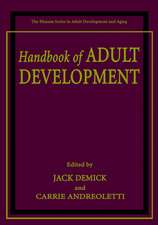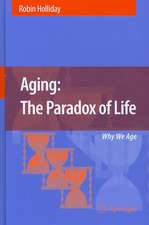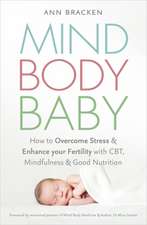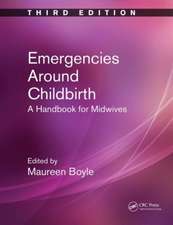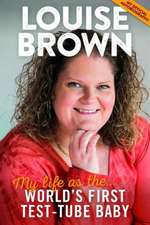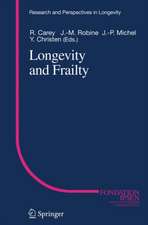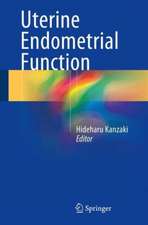Comparative Biology of Aging
Editat de Norman S. Wolfen Limba Engleză Hardback – 4 feb 2010
| Toate formatele și edițiile | Preț | Express |
|---|---|---|
| Paperback (1) | 1415.54 lei 6-8 săpt. | |
| SPRINGER NETHERLANDS – 12 noi 2014 | 1415.54 lei 6-8 săpt. | |
| Hardback (1) | 1421.21 lei 6-8 săpt. | |
| SPRINGER NETHERLANDS – 4 feb 2010 | 1421.21 lei 6-8 săpt. |
Preț: 1421.21 lei
Preț vechi: 1496.01 lei
-5% Nou
Puncte Express: 2132
Preț estimativ în valută:
272.03€ • 295.59$ • 228.66£
272.03€ • 295.59$ • 228.66£
Carte tipărită la comandă
Livrare economică 21 aprilie-05 mai
Preluare comenzi: 021 569.72.76
Specificații
ISBN-13: 9789048134649
ISBN-10: 9048134641
Pagini: 300
Ilustrații: IX, 391 p.
Dimensiuni: 155 x 235 x 29 mm
Greutate: 0.7 kg
Ediția:2010
Editura: SPRINGER NETHERLANDS
Colecția Springer
Locul publicării:Dordrecht, Netherlands
ISBN-10: 9048134641
Pagini: 300
Ilustrații: IX, 391 p.
Dimensiuni: 155 x 235 x 29 mm
Greutate: 0.7 kg
Ediția:2010
Editura: SPRINGER NETHERLANDS
Colecția Springer
Locul publicării:Dordrecht, Netherlands
Public țintă
ResearchCuprins
Introduction: Lifespans and Pathologies Present at Death in Laboratory Animals.- Animal Size, Metabolic Rate, and Survival, Among and Within Species.- Hormonal Influences on Aging and Lifespan.- Exploring Mechanisms of Aging Retardation by Caloric Restriction: Studies in Model Organisms and Mammals.- Cell Replication Rates In Vivo and In Vitro and Wound Healing as Affected by Animal Age, Diet, and Species.- Sirtuin Function in Longevity.- The Role of TOR Signaling in Aging.- Mitochondria, Oxidative Damage and Longevity: What Can Comparative Biology Teach Us?.- Comparative Genomics of Aging.- Changes in Lysosomes and Their Autophagic Function in Aging: The Comparative Biology of Lysosomal Function.- Telomeres and Telomerase.- Cardiac Aging.- Comparative Skeletal Muscle Aging.- Aging of the Nervous System.- Aging of the Immune System Across Different Species.
Textul de pe ultima copertă
Cover copy: Wolf, Norman (ed.), The Comparative Biology of Aging
The processes of aging and death remain one of the most fascinating, and mysterious, areas of biological research. Huge anomalies between species raise questions the answers to which could have fundamental implications for the field of medical science. As scientists unlock the secrets of the exceptionally long-lived little brown bat (up to 34 years), or the common Budgerigar which despite having a metabolic rate 1.5 times that of a laboratory mouse, can live for up to 20 years, it has become more important than ever to be able to make a comparative analysis of the various species used in research.
Dealing with every one of the species that are employed in laboratory research, this is the first book on the subject of aging that provides detailed comparative data for age-related changes in its subjects. It does so at the level of the whole animal, its organs, organelles and molecules. The comparative data, supplied in 15 chapters by leading experts, provides information on fields as disparate as telomere function and loss, the importance of the Sirtuins and Tor, the influence of hormones on lifespans, the relationship between body size and lifespan, the effects of restricted calorific intake, age-related changes in cell replication, and DNA damage and repair. Chapters are devoted to cardiac aging, comparative skeletal muscle aging, the aging of the nervous and immune systems, the comparative biology of lyosomal function and how it is affected by age, and many other key areas of research.
This much-needed text will provide scientists working in a wide spectrum of fields with key data to aid them in their studies.
The processes of aging and death remain one of the most fascinating, and mysterious, areas of biological research. Huge anomalies between species raise questions the answers to which could have fundamental implications for the field of medical science. As scientists unlock the secrets of the exceptionally long-lived little brown bat (up to 34 years), or the common Budgerigar which despite having a metabolic rate 1.5 times that of a laboratory mouse, can live for up to 20 years, it has become more important than ever to be able to make a comparative analysis of the various species used in research.
Dealing with every one of the species that are employed in laboratory research, this is the first book on the subject of aging that provides detailed comparative data for age-related changes in its subjects. It does so at the level of the whole animal, its organs, organelles and molecules. The comparative data, supplied in 15 chapters by leading experts, provides information on fields as disparate as telomere function and loss, the importance of the Sirtuins and Tor, the influence of hormones on lifespans, the relationship between body size and lifespan, the effects of restricted calorific intake, age-related changes in cell replication, and DNA damage and repair. Chapters are devoted to cardiac aging, comparative skeletal muscle aging, the aging of the nervous and immune systems, the comparative biology of lyosomal function and how it is affected by age, and many other key areas of research.
This much-needed text will provide scientists working in a wide spectrum of fields with key data to aid them in their studies.
Caracteristici
The first book devoted exclusively and comprehensively to the Comparative Biology of Aging Compares as many species as possible for the biological and molecular changes that occur with aging Discussing aging changes in various cells tissues and organs as well as the regimens and treatments that delay or accelerate their aging Broadly focussed, both from a multi-species approach and a multi-tissue approach The contributing chapter authors are experts in their fields Both cell and organelle aging as well as full systemic changes are discussed

